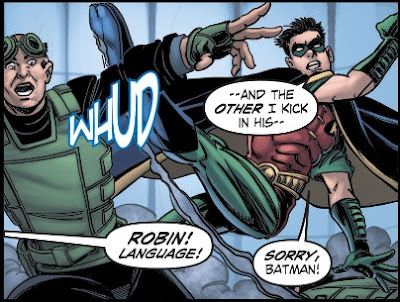Elements of a Digital Dynamic Duo Story
“Elements of Crime,” the story in Legends of the Dark Knight, digital issues #63-65, features a version of the Dynamic Duo never seen before.
The story comes principally from two comics creators with significant experience portraying Batman and Robin. Mike W. Barr scripted many issues of Detective Comics in the 1980s and the Son of a Demon graphic novel that inspired Grant Morrison to create Damian Wayne. Tom Lyle penciled the three Robin miniseries in the early 1990s, establishing the look (well, the now-embarrassing haircut) of Tim Drake.
Lyle’s visual depictions of Batman and Robin in this Legends of the Dark Knight digital-first tale basically match those from the 1990s. Tim is back in his original uniform. Batman doesn’t have the yellow oval around his bat symbol but otherwise looks quite familiar.
But Barr’s dialogue is well out of time. This Batman takes polite leave of Commissioner Gordon and chides Robin for using the mildest of racy language, like “get to first base.” In sum, this is the Batman of the 1960s television show. As for Tim as Robin, he’s hard-working and gets the computer jobs, but he’s also uncharacteristically hot-headed and loud-mouthed.
What’s more, the Batmobile in this story is the version seen in Gotham City before the “New Look” of 1964, with a big bat face on the front and a big fin sticking out the back. Far from acting in the shadows, this Batman is welcome at the Pentagon. And the story itself is a throwback, with the villain deliberately sending Gordon clues about upcoming crimes.
Thus, the story is not just not part of the “New52” universe—it doesn’t quite fit into any of DC’s many continuities over the years. That reflects how the company’s digital-first wing is free of the burden of consistency. Batman: Li’l Gotham likewise serves fans all the happiest bits of the pre-New52 universe, and other digital titles take off of TV shows instead of the current comics.
I wish I could say that “Elements of Crime” was an unalloyed delight because of those old-fashioned touches, but I struggled with the story. Despite several readings I still can’t tell you how Batman escaped the Element Queen’s death trap the first time. Robin does nothing but play Boy Hostage. The art in the last installment sometimes seems unaccountably awkward.
I noticed an interesting lettering technique, though. When characters are speaking on the other side of glass from readers, Saida Temofonte’s balloon tales end in little arrows on the glass surface, as shown in the first two pictures above.
The story comes principally from two comics creators with significant experience portraying Batman and Robin. Mike W. Barr scripted many issues of Detective Comics in the 1980s and the Son of a Demon graphic novel that inspired Grant Morrison to create Damian Wayne. Tom Lyle penciled the three Robin miniseries in the early 1990s, establishing the look (well, the now-embarrassing haircut) of Tim Drake.
Lyle’s visual depictions of Batman and Robin in this Legends of the Dark Knight digital-first tale basically match those from the 1990s. Tim is back in his original uniform. Batman doesn’t have the yellow oval around his bat symbol but otherwise looks quite familiar.
But Barr’s dialogue is well out of time. This Batman takes polite leave of Commissioner Gordon and chides Robin for using the mildest of racy language, like “get to first base.” In sum, this is the Batman of the 1960s television show. As for Tim as Robin, he’s hard-working and gets the computer jobs, but he’s also uncharacteristically hot-headed and loud-mouthed.
What’s more, the Batmobile in this story is the version seen in Gotham City before the “New Look” of 1964, with a big bat face on the front and a big fin sticking out the back. Far from acting in the shadows, this Batman is welcome at the Pentagon. And the story itself is a throwback, with the villain deliberately sending Gordon clues about upcoming crimes.
Thus, the story is not just not part of the “New52” universe—it doesn’t quite fit into any of DC’s many continuities over the years. That reflects how the company’s digital-first wing is free of the burden of consistency. Batman: Li’l Gotham likewise serves fans all the happiest bits of the pre-New52 universe, and other digital titles take off of TV shows instead of the current comics.
I noticed an interesting lettering technique, though. When characters are speaking on the other side of glass from readers, Saida Temofonte’s balloon tales end in little arrows on the glass surface, as shown in the first two pictures above.





2 comments:
Little arrows? Because when there's glass the cleaner pointer can't penetrate?
Or perhaps because we're not seeing the sound waves directly from their mouths, but rather the secondary vibrations coming off the glass.
Post a Comment